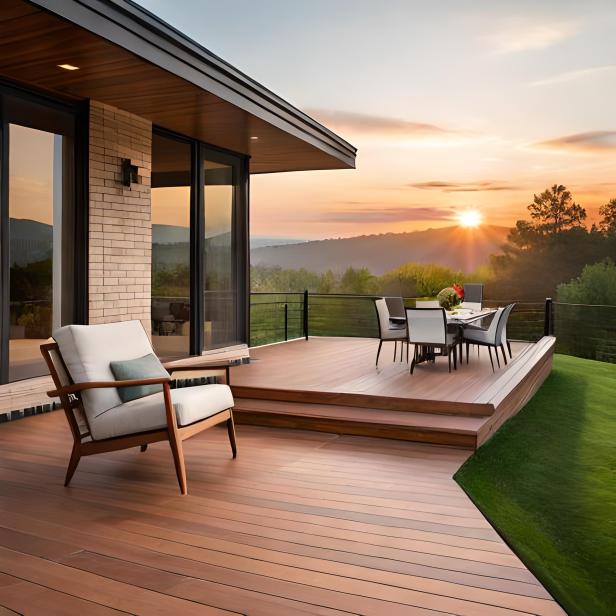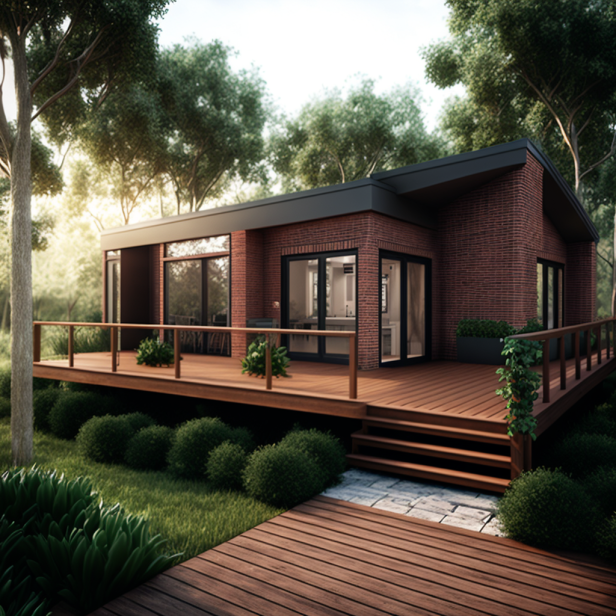Imagine enjoying a warm summer day on a beautiful deck attached to your brick house. The sound of birds chirping, the gentle breeze, and the sun’s soothing rays create the perfect ambiance for relaxation and entertainment. Adding a deck to your brick house enhances its visual appeal and provides a functional space to enjoy outdoor activities. In this comprehensive guide, we will walk you through the process of adding a deck to your brick house, from planning and preparation to the finishing touches. Get ready to transform your outdoor living space into a stunning oasis.
Planning and Preparation
Before diving into the construction phase, careful planning and preparation are essential. Taking the time to plan will ensure that your deck integrates seamlessly with your brick house and meets your specific needs. Here are the key steps to follow:
- Check local building codes. Before planning your deck, you must check the local building codes to ensure your deck meets all the requirements. This will vary depending on where you live, so research.
- Get a permit. Sometimes, you may need to get a license to build a deck. This is especially true if your deck is large or in a particular area.
- Create a deck plan. Once you know the size and shape of your deck, you can start creating a plan. This will help you visualize the finished product and ensure everything is aligned correctly.
- Choose suitable deck materials. As mentioned above, the materials you choose for your deck will depend on your budget, preferences, and home style. Some popular options include wood, composite decking, and PVC.
- Consider the deck’s purpose. What will you be using your deck for? To entertain guests, you’ll need an enormous balcony with more seating. If you want a quiet relaxing place, you can get away with a smaller deck.
- Factor in the cost of materials and labor. Deck construction can be expensive, so it’s essential to factor in the price of materials and delivery before planning.
You can start building your deck after completing the planning and preparation phase!
Here are some additional tips for planning and preparing for deck construction:
- Get professional help if you’re unsure how to plan or build a deck; getting professional service is a good idea. A contractor can help you design a deck that meets your needs and budget.
- Start small. Starting small is a good idea if you’re new to deck construction. This will allow you to learn the basics and build your confidence.
- Be patient. Deck construction can be a time-consuming process. Be patient, and don’t rush the job.
With careful planning and preparation, you can build a beautiful and functional deck that will add value to your home.
Building the Base
The foundation of your deck is crucial for its stability and longevity. Here’s a step-by-step guide on how to build a solid deck base:
- Digging the postholes: When searching the postholes, it is essential to use a posthole digger that is the correct size for the posts you will be using. The depth of the postholes will depend on the frost line in your area, as well as the size and weight of the deck. In general, the postholes should be at least 3 feet deep.
- Setting the footers: Once the postholes are dug, you must select the footers. Footers are concrete slabs that provide a solid base for the support posts. The footers should be at least 12 inches square and 4 inches thick.
- Attaching the support posts to the house: After the footers have cured, you can attach the support posts to the house. There are various methods for connecting the rods to the house, but the most common way is to use metal brackets. The brackets should be attached to the house using lag screws or bolts.
It is important to note that the specific steps involved in building the base of a deck will vary depending on the size and design of the deck. However, the general principles outlined above will apply to most decks.
Here are some additional tips for building a solid deck base:
- Use the correct size and type of posts: The size and type of seats you use will depend on the size and weight of the deck. You should generally use pressure-treated posts for decks in areas with high moisture content.
- Use the correct type of concrete: Your concrete will depend on the frost line in your area. In general, you should use a concrete mix designed for below-grade applications.
- Level the footers: Leveling them before setting the support posts is essential. This will ensure that the seats are plumb and level, which will help ensure the deck’s structural integrity.
- Use corrosion-resistant hardware: The hardware you use to attach the posts to the house should be corrosion-resistant. This will help to prevent the hardware from rusting and failing over time.
Following these tips, you can build a solid deck base supporting your deck for many years.

Framing and Decking
Now that the base is in place, it’s time to move on to framing and decking. This stage involves constructing the deck’s framework and installing the decking boards. Follow these steps for a successful structure and decking process:
- Attaching beams and joists: The beams and joists are the main structural elements of a deck, so it is essential to ensure they are securely fastened. The beams should be attached to the support posts using lag screws or bolts, and the joists should be attached to the beams using joist hangers.
- Choosing the suitable materials: The framing and decking materials you choose will depend on the size and weight of the deck, as well as your budget and preferences. Pressure-treated lumber is a popular choice for framing due to its strength and resistance to rot and insects. You can opt for natural wood, composite decking, or PVC boards for the decking surface. Each material has advantages and appearance, so choose the one that best suits your needs.
- Considering brick house integration: When designing your deck, consider your brick house’s architectural style. You can incorporate brick accents or matching color schemes to create a cohesive and visually appealing look. Consulting with an architect or a deck builder can provide valuable insights and ensure seamless integration between your deck and brick house.
Here are some additional tips for framing and decking a deck on a brick house:
- Use corrosion-resistant hardware: The hardware you use to attach the beams and joists should be corrosion-resistant. This will help to prevent the hardware from rusting and failing over time.
- Use flashing: Flashing is used to prevent water from leaking between the deck and the house. It is essential to install flashing correctly to avoid water damage.
- Seal the deck: Once it is built, sealing it to protect it from the elements is essential. There are a variety of sealants available, so choose one that is specifically designed for decks.
Following these tips, you can build a sturdy, attractive deck that will last many years.
Finish and Maintenance
- Adding railings and stairs: Railings and stairs are essential for safety and can add a style touch to your deck. When choosing bars, consider the style of your home and the size of your deck. There are a variety of railing styles available, from simple to ornate. Stairs should be wide enough for comfortable passage and have a non-slip surface.
- Maintaining your deck: Regular maintenance is essential to keep your deck looking its best and extending its lifespan. Here are some tips for maintaining your deck:
- Clean your deck regularly: Dirt, debris, and mildew can build up on your deck over time, making it look dirty and unsightly. To clean your deck, use a mild detergent and a soft brush. Be sure to rinse the deck thoroughly after cleaning.
- Inspect your deck for damage: Inspect your deck regularly for any signs of wear, such as loose boards, cracked joists, or rusted fasteners. Make repairs as needed to prevent further damage.
- Seal or stain your deck: Sealing or staining your deck will help to protect it from the elements and prevent weathering. There are a variety of sealers and stains available, so choose one specifically designed for decks.
- Trim vegetation around your deck: Vegetation around your patio can harbor pests and moisture, damaging your deck. Trim vegetation back to at least 12 inches from the edge of your deck.
Following these tips, you can keep your deck looking its best for years.
Here are some additional tips for maintaining your deck:
- Use a pressure washer: A pressure washer can be a helpful tool for cleaning your deck, but it is essential to use it carefully. Use a low-pressure setting and avoid spraying the deck directly with the water jet.
- Stain or seal your deck every 2-3 years: This will help to protect the wood from the elements and prevent fading.
- Replace any damaged boards: If any panels on your deck are damaged, replace them as soon as possible. This will help to prevent further damage and keep your deck safe.
- Store your outdoor furniture properly: When the weather is not cooperating, store your outdoor furniture in a dry, covered area. This will help to prevent it from getting damaged by the elements.
Following these tips, you can keep your deck looking its best and extend its lifespan.
In Conclusion, adding a deck to your brick house is a fantastic way to enhance your outdoor living experience and create a space for relaxation, entertainment, and connection with nature. Following the steps outlined in this comprehensive guide, you’ll be well-equipped to plan, build, and maintain a beautiful deck that seamlessly integrates with your brick house’s architectural style. Don’t hesitate to consult professionals for guidance and assistance throughout the process. Start envisioning the deck of your dreams and take the first step towards transforming your outdoor space into a haven of tranquility and enjoyment. Contact a reputable deck builder or architect today and embark on your deck-building journey. Your brick house will thank you for it.

